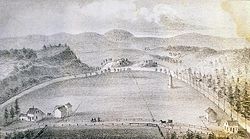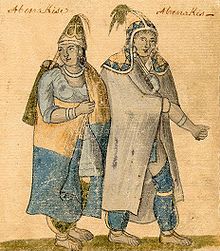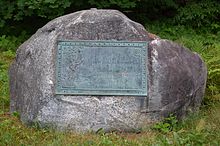Norridgewock
Norridgewock Archeological District | |
 Old Point in 1849 | |
| Location | Norridgewock, Starks, and Madison, Maine |
|---|---|
| Coordinates | 44°46′1″N 69°53′0″W / 44.76694°N 69.88333°W |
| Built | 1625 |
| NRHP reference No. | 93000606 [1] |
| Significant dates | |
| Added to NRHP | April 12, 1993 |
| Designated NHLD | April 12, 1993[2] |
Norridgewock was the name of both an Indigenous village and a band of the Abenaki ("People of the Dawn") Native Americans/First Nations, an Eastern Algonquian tribe of the United States and Canada. The French of New France called the village Kennebec. The tribe occupied an area in the interior of Maine. During colonial times, this area was territory disputed between British and French colonists, and was set along the claimed western border of Acadia, the western bank of the Kennebec River.
Archaeological evidence has identified several different sites associated with the settlement known as Norridgewock. The last one, where the French Jesuit priest
Norridgewock village
Norridgewock is a corruption of the word Nanrantsouak, meaning "people of the still water between the rapids."[ and seafowl.
France claimed the Kennebec River because it provided a potential route to invade
In 1694, Father
... a large handsome log building adorned with many pictures and toys to please the Indians ...
Speaking the Abenaki language fluently, Father Rale immersed himself in Indian affairs. His "astonishing influence over their minds" raised suspicions that he was inciting hostility toward the
King William's War
Raid on Oyster River
During
Queen Anne's War

When
Raid on Wells (1703)
As part of the
Raid on Norridgewock (1705)
In retaliation, there was a bounty put on Father Rale. Finding the village deserted in the winter of 1705 because its occupants, including Rale had been warned of an impending attack, Colonel Winthrop Hilton ordered his 275 English colonial militia to burn the village and the church.[3][5]
With the
In 1713, the Norridgewocks had sought peace with English at the Treaty of Portsmouth, and accepted the convenience of trading posts operated by English settlers on their land (though they protested the tendency of the settlers to cheat them). After all, beaver and other skins could be exchanged for cheap goods following a journey of one or two days, when travel to Quebec up the Kennebec, with its rapids and portages, required over 15 days.
Father Rale's War

But their acceptance of English settlers faded as Rale instigated the tribe against the encroachment of houses and blockhouses that followed trading posts. He taught the Abenaki that their territory should be held in trust for their children. On July 28, 1721, 250 Abenakis in 90 canoes delivered a letter at Georgetown addressed to Governor Samuel Shute, demanding that English settlers quit Abenaki lands. Otherwise, they would be killed and their settlements destroyed.
Raid on Norridgewock (1722)
In response, Norridgewock was raided in January 1722 by 300 English colonial militia under Colonel
Battle of Norridgewock (1724)



During
Legacy
Norridgewock Village is the setting for the 1836 poem Mogg Megone by John Greenleaf Whittier.
Archaeological investigation of the Old Point area has identified three separate areas that are historically associated with the appellation "Norridgewock". The principal site at Old Point has long been well documented, and was listed on the
See also
- List of National Historic Landmarks in Maine
- National Register of Historic Places listings in Somerset County, Maine
References
- Endnotes
- ^ a b "National Register Information System". National Register of Historic Places. National Park Service. April 15, 2008.
- ^ a b "Norridgewock Archeological District". National Historic Landmark summary listing. National Park Service. Archived from the original on 2010-09-23. Retrieved 2008-06-25.
- ^ a b Charland, Thomas (1979) [1969]. "Rale, Sébastien". In Hayne, David (ed.). Dictionary of Canadian Biography. Vol. II (1701–1740) (online ed.). University of Toronto Press.
- ^ Comeau, J.-Roger (1979) [1969]. "Leneuf de La Vallière de Beaubassin, Alexandre". In Hayne, David (ed.). Dictionary of Canadian Biography. Vol. II (1701–1740) (online ed.). University of Toronto Press.
- ^ Schuyler, H.C. "The Apostle of the Abnakis: Father Sebastian Rale, S.J. (1657-1724)". The Catholic Historical Review. 1 (2): 168.
- ^ "NRHP nomination for Old Point and Sebastian Rale Monument". National Park Service. Retrieved 2015-05-05.
- ^ "Research and Preservation and Norridgewock NHL" (PDF). National Park Service. Retrieved 2015-04-27.
- Texts
- Fiske, John (1902). "Norridgewock and Louisburg". New France and New England. Houghton Mifflin. pp. 233–257.
- Parkman, Francis (1893). A Half-Century of Conflict. Boston: Little, Brown, and Company.
- Prins, Harald E.L (with B. Bourque), 1987, "Norridgewock: Village Translocation on the New England Acadian Frontier." Man in the Northeast, No. 33, pp. 137–58.
- Sylvester, Herbert Milton (1910). Indian Wars of New England. Vol. III. Boston: W.B. Clarke Company. ISBN 978-0-7884-1079-6.
- Matteo Binasco. "Few, Uncooperative, and Endangered: The Troubled Activity of the Roman Catholic missionaries in Acadia (1610-1710)", in Royal Nova Scotia Historical Society, Journal, vol.10 (2007), pp. 147–162.


